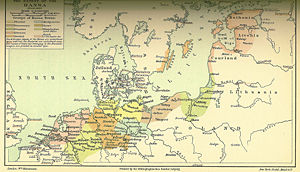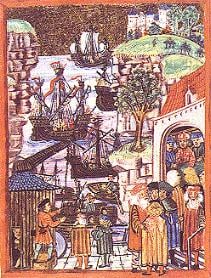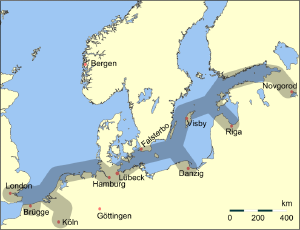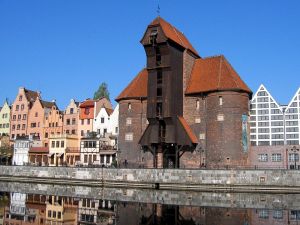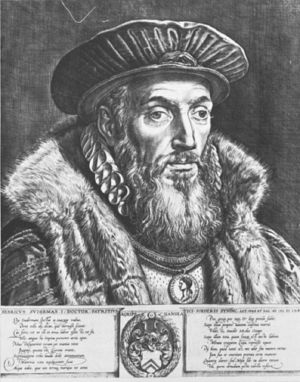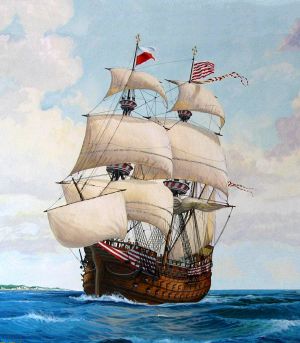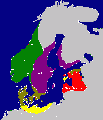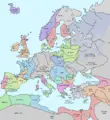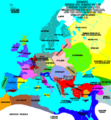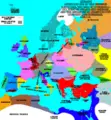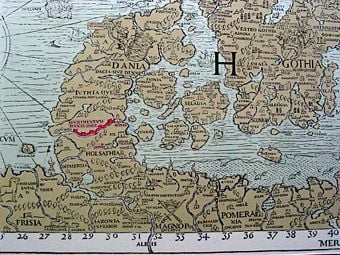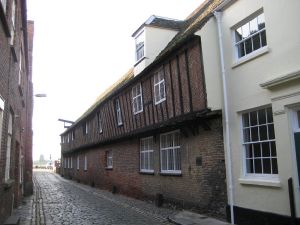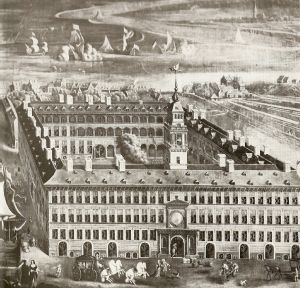Hanseatic League
The Hanseatic League (also known as the Hansa) was an alliance of trading guilds that established and maintained a trade monopoly along the coast of Northern Europe, from the Baltic to the North Sea, during the Late Middle Ages and Early modern period (circa thirteenth–seventeenth centuries). Rival cities cooperated within the League to defend themselves from pirates as well as to compete against larger economic powers. The League is widely regarded as a forerunner of the European Community both as a free trade zone and as an entity that had to balance the interests of the larger polity with the identities and interests of its members on the other.[1][2] For almost four centuries, the League maintained its own military, an exchange mechanism, regulated tariffs and even had a Parliament (Diet, the Hansetage), although this met infrequently. There were also regional and district diets.
The League aimed to protect trade, which meant that maintaining peace was also a major concern. It sometimes waged war but favored peace. The making of war and peace was discussed in the Diet. Unlike the EU, though, for most of its history the League had no permanent official; it was not until 1556 that Heinrich Suderman was appointed Syndic, (representative).[3]The League's decline has been attributed to increased competition from England, Netherlands, Denmark and Sweden as these states grew more powerful and to social unrest resulting from the Protestant Reformation. By 1648, some Hanseatic towns had fallen to Sweden and merchants had been expelled from Holland. The League, however, was included in the Peace of Westphalia when it was mentioned for the first time in "an official document of the Holy Roman Empire".[3]. On the one hand, the League's prosperity probably did not trickle down to the non-elite of its cities. On the other hand, for much of its history, all citizens enjoyed long periods of peace and stability based almost exclusively on its preference for trade over war. The founding fathers of the European Union were also convinced that trade, resource sharing and economic convergence would prevent war and promote peace. Behind this stand the achievements of the Hanseatic League.
History
Historians generally trace the origins of the League to the rebuilding of the North German town of Lübeck in 1159 by Duke Henry the Lion of Saxony, after Henry had captured the area from Count Adolf II of Holstein.
Exploratory trading adventures, raids and piracy had happened earlier throughout the Baltic (see Vikings) — the sailors of Gotland sailed up rivers as far away as Novgorod, for example — but the scale of international economy in the Baltic area remained insignificant before the growth of the Hanseatic League.
German cities achieved domination of trade in the Baltic with striking speed over the next century, and Lübeck became a central node in all the sea-borne trade that linked the areas around the North Sea and the Baltic Sea. The fifteenth century saw the climax of Lübeck's hegemony. Visby, one of the midwives of the Hanseatic League in 1358, declined to become a member. Visby dominated trade in the Baltic before the Hanseatic League, and with its monopolistic ideology, suppressed the Gotlandic free-trade competition.
Foundation
Lübeck became a base for merchants from Saxony and Westphalia to spread east and north. Well before the term Hanse appeared in a document (1267), merchants in a given city began to form guilds or Hansa with the intention of trading with towns overseas, especially in the less-developed eastern Baltic area, a source of timber, wax, amber, resins, furs, even rye and wheat brought down on barges from the hinterland to port markets.
Visby functioned as the leading centre in the Baltic before the Hansa. For 100 years the Germans sailed under the Gotlandic flag to Novgorod. Sailing east, Visby merchants established a branch at Novgorod. To begin with the Germans used the Gotlandic Gutagard. With the influx of too many merchants the Gotlanders arranged their own trading stations for the German Petershof further up from the river—see a translation of the grant[4] of privileges to merchants in 1229. Before the foundation of the Hanseatic league in 1358 the word Hanse did not occur in the Baltic. The Gotlanders used the word varjag.
Hansa societies worked to acquire special trade privileges for their members. For example, the merchants of the Cologne Hansa contrived to convince Henry II of England to grant them (1157) special trading privileges and market rights which freed them from all London tolls and allowed them to trade at fairs throughout England. The "Queen of the Hansa," Lübeck, where traders trans-shipped goods between the North Sea and the Baltic, gained the Imperial privilege of becoming an Imperial city in 1227, the only such city east of the River Elbe.
Lübeck, which had access to the Baltic and North Sea fishing grounds, formed an alliance in 1241 with Hamburg, another trading city, which controlled access to salt-trade routes from Lüneburg. The allied cities gained control over most of the salt-fish trade, especially the Scania Market; and Cologne joined them in the Diet of 1260. In 1266 Henry III of England granted the Lübeck and Hamburg Hansa a charter for operations in England, and the Cologne Hansa joined them in 1282 to form the most powerful Hanseatic colony in London. Much of the drive for this co-operation came from the fragmented nature of existing territorial government, which failed to provide security for trade. Over the next 50 years the Hansa itself emerged with formal agreements for confederation and co-operation covering the west and east trade routes. The chief city and linchpin remained Lübeck; with the first general Diet of the Hansa held there in 1356, the Hanseatic League acquired an official structure and could date its official founding.
Expansion
Lübeck's location on the Baltic provided access for trade with Scandinavia and Russia, putting it in direct competition with the Scandinavians who had previously controlled most of the Baltic trade routes. A treaty with the Visby Hansa put an end to competition: through this treaty the Lübeck merchants also gained access to the inland Russian port of Novgorod, where they built a trading post or Kontor. Other such alliances formed throughout the Holy Roman Empire. The League never became a closely-managed formal organization. Assemblies of the Hanseatic towns met irregularly in Lübeck for a Hansetag, from 1356 onwards, but many towns chose not to send representatives and decisions were not binding individual cities. Over time, the network of alliances grew to include a flexible roster of 70 to 170 cities.[5]
The league succeeded in establishing additional Kontors in Bruges (Flanders), Bergen (Norway), and London (England). These trading posts became significant enclaves. The London Kontor, established in 1320, stood west of London Bridge near Upper Thames Street. (Cannon Street station occupies the site now.) It grew significantly over time into a walled community with its own warehouses, weighhouse, church, offices and houses, reflecting the importance and scale of the activity carried on. The first reference to it as the Steelyard (der Stahlhof) occurs in 1422.
In addition to the major Kontors, individual Hanseatic ports had a representative merchant and warehouse. In England this happened in Boston, Bristol, Bishop's Lynn (now King's Lynn), which features the sole remaining Hanseatic warehouse in England, Hull, Ipswich, Norwich, Yarmouth (now Great Yarmouth), and York.
The League primarily traded timber, furs, resin (or tar), flax, honey, wheat, and rye from the east to Flanders and England with cloth (and, increasingly, manufactured goods) going in the other direction. Metal ore (principally copper and iron) and herring came southwards from Sweden.
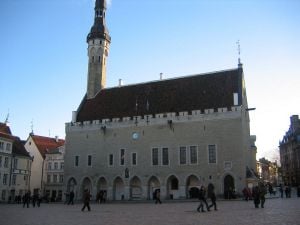
German colonists under strict Hansa supervision built numerous Hansa cities on and near the east Baltic coast, such as Danzig (Gdańsk), Elbing (Elblag), Thorn (Toruń), Reval (Tallinn), Riga, and Dorpat (Tartu), some of which still retain many Hansa buildings and bear the style of their Hanseatic days. Most were founded under Lübeck law, which provided that they had to appeal in all legal matters to Lübeck's city council. The Livonian Confederation incorporated parts of modern-day Estonia and Latvia and had its own Hanseatic parliament (diet); all of its major towns became members of the Hanseatic League. The dominant language of trade was Middle Low German, a dialect with significant impact for countries involved in the trade, particularly the larger Scandinavian languages.
Zenith
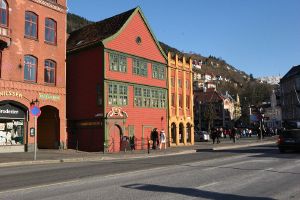
The League had a fluid structure, but its members shared some characteristics. First, most of the Hansa cities either started as independent cities or gained independence through the collective bargaining power of the League. Such independence remained limited, however. The Hanseatic free imperial cities owed allegiance directly to the Holy Roman Emperor, without any intermediate tie to the local nobility. Another similarity involved the cities' strategic locations along trade routes. In fact, at the height of its power in the late 1300s, the merchants of the Hanseatic League succeeded in using their economic clout (and sometimes their military might - trade routes needed protecting, and the League's ships sailed well-armed) to influence imperial policy.
The League also wielded power abroad: between 1368 and 1370, Hansa ships unified in the Confederation of Cologne fought against the Danes, and forced King Valdemar IV of Denmark to grant the League 15 percent of the profits from Danish trade (Treaty of Stralsund, 1370) and an effective trade monopoly in Scandinavia. The Hansa also waged a vigorous campaign against pirates. Between 1392 and 1440, maritime trade of the League faced danger from raids of the Victual Brothers and their descendants, privateers hired in 1392 by Albert of Mecklenburg against the Queen Margaret I of Denmark. In the Dutch-Hanseatic War (1438—1441), the merchants of Amsterdam sought and eventually won free access to the Baltic and broke the Hansa monopoly. As an essential part of protecting their investment in trade and ships, the League trained pilots and erected lighthouses.
Exclusive trade routes often came at a high price. Most foreign cities confined the Hansa traders to certain trading areas and to their own trading posts. They could seldom, if ever, interact with the local inhabitants, except in the matter of actual negotiation. Moreover, many people, merchant and noble alike, envied the power of the League. For example, in London the local merchants exerted continuing pressure for the revocation of the privileges of the League. The refusal of the Hansa to offer reciprocal arrangements to their English counterparts exacerbated the tension. King Edward IV of England reconfirmed the league's privileges in the Treaty of Utrecht (1474) despite this hostility, in part thanks to the significant financial contribution the League made to the Yorkist side during The Wars of the Roses. A century later, in 1597, Queen Elizabeth I of England expelled the League from London and the Steelyard closed the following year. The very existence of the League and its privileges and monopolies created economic and social tensions that often crept over into rivalry between League members.
Downfall
The economic crises of the late fourteenth century did not spare the Hansa. Nevertheless, its eventual rivals emerged in the form of the territorial states, whether new or revived, and not just in the west: Poland triumphed over the Teutonic Knights in 1466; Ivan III of Russia ended the entrepreneurial independence of Novgorod in 1478. New vehicles of credit imported from Italy outpaced the Hansa economy, in which silver coin changed hands rather than bills of exchange.
In the fourteenth century, tensions between Prussia and the Wendish cities (Lübeck and neighbors) rose. Lübeck was dependent on its role as centre of the Hansa, being on the shore of the sea without a major river. Lübeck was on the entrance of the land route to Hamburg, but this land route could be circumvented by the sea travel around Denmark and through the Sound. Prussia's main interest, on the other hand, was primarily the export of bulk products like grain and timber, which were very important for England, the Low Countries, and later on also for Spain and Italy.
In 1454, the towns of the Prussian Confederation rose against the dominance of the Teutonic Order and asked for help from King Casimir IV of Poland. Danzig, Thorn, and Elbing were incorporated into the Kingdom of Poland as part of Royal Prussia by the Second Peace of Thorn (1466). Kraków, then the capital of Poland, was also a Hansa city. The lack of customs borders on the River Vistula after 1466 helped to gradually increase Polish grain export, transported to the sea down the Vistula, from 10,000 tonnes per year in the late fifteenth century to over 200,000 tonnes in the seventeenth century. The Hansa-dominated maritime grain trade made Poland one of the main areas of its activity, helping Danzig to become the Hansa's largest city due to its control of Polish grain exports.
A major benefit for the Hansa was its domination of the shipbuilding market, mainly in Lübeck and in Danzig. The Hansa sold ships everywhere in Europe, including Italy. The Hansa had excluded the Hollanders, because it wanted to favor Bruges as a huge staple market at the end of a trade route. When the Hollanders started to become competitors of the Hansa in shipbuilding, the Hansa tried to stop the flow of shipbuilding technology from Hansa towns to Holland. Danzig, a trading partner of Amsterdam, tried to stall the decision. Dutch ships sailed to Danzig to take grain from the Prussians directly, to the dismay of Lübeck. Hollanders also circumvented the Hansa towns by trading directly with North German princes in non-Hansa towns. Dutch freight costs were much lower than those of the Hansa, and the Hansa were excluded as middlemen.
Bruges, Antwerp and Holland all became part of the same country, the Duchy of Burgundy, which actively tried to take over the monopoly of trade from the Hansa, and the staple market from Bruges was moved to Amsterdam. The Dutch merchants aggressively challenged the Hansa and met with much success. Hanseatic cities in Prussia, Livonia and Poland supported the Dutch against the core cities of the Hansa in northern Germany. After several naval wars between Burgundy and the Hanseatic fleets, Amsterdam gained the position of leading port for Polish and Baltic grain from the late fifteenth century onwards. The Dutch regarded Amsterdam's grain trade as the mother of all trades (Moedernegotie). Denmark and England tried to destroy the Netherlands in the early sixteenth century, but failed.
Nuremberg in Franconia developed an overland route to sell formerly Hansa monopolized products from Frankfurt via Nuremberg and Leipzig to Poland and Russia, trading Flemish cloth and French wine in exchange for grain and furs from the east. The Hansa profited from the Nuremberg trade by allowing Nurembergers to settle in Hansa towns, which the Franconians exploited by taking over trade with Sweden as well. The Nuremberger merchant Albrecht Moldenhauer was influential in developing the trade with Sweden and Norway, and his sons Wolf and Burghard established themselves in Bergen and Stockholm, becoming leaders of the Hanseatic activities locally.
End of the Hansa
At the start of the sixteenth century the League found itself in a weaker position than it had known for many years. The rising Swedish Empire had taken control of much of the Baltic. Denmark had regained control over its own trade, the Kontor in Novgorod had closed, and the Kontor in Bruges had become effectively defunct. The individual cities which made up the League had also started to put self-interest before their common Hansa interests. Finally the political authority of the German princes had started to grow — and so to constrain the independence of action which the merchants and Hanseatic towns had enjoyed.
The League attempted to deal with some of these issues. It created the post of Syndic in 1556 and elected Heinrich Sudermann as permanent official with legal training who worked to protect and extend the diplomatic agreements of the member towns. In 1557 and 1579 revised agreements spelled out the duties of towns and some progress was made. The Bruges Kontor moved to Antwerp and the Hansa attempted to pioneer new routes. However, the League proved unable to halt the progress around it and so a long decline commenced. The Antwerp Kontor closed in 1593, followed by the London Kontor in 1598. The Bergen Kontor continued until 1754; its buildings alone of all the Kontoren survive (see Bryggen). The Diet met for the last time in 1669.
The gigantic Adler von Lübeck, which was constructed for military use against Sweden during the Northern Seven Years' War (1567-1570), but never put to action, epitomizes the vain attempts of the League's leading city Lübeck to uphold its long privileged commercial position in a changed economic and political climate.
By the late sixteenth century, the League imploded and could no longer deal with its own internal struggles, the social and political changes that accompanied the Protestant Reformation, the rise of Dutch and English merchants, and the incursion of the Ottoman Empire upon its trade routes and upon the Holy Roman Empire itself. Only nine members attended the last formal meeting in 1669 and only three (Lübeck, Hamburg and Bremen) remained as members until its final demise in 1862.
Despite its collapse, several cities still maintain the link to the Hanseatic League today. The Dutch cities of Deventer, Kampen, Zutphen, and the nine German cities Bremen, Demmin, Greifswald, Hamburg, Lübeck, Lüneburg, Rostock, Stralsund and Wismar still call themselves Hanse cities. Lübeck, Hamburg, and Bremen continue to style themselves officially as "Free and Hanseatic Cities." (Rostock's football team is named F.C. Hansa Rostock in memory of the city's trading past.) For Lübeck in particular, this anachronistic tie to a glorious past remained especially important in the twentieth century. In 1937 the Nazis removed this privilege through the Greater Hamburg Act after the Senat of Lübeck did not permit Adolf Hitler to speak in Lübeck during his election campaign.[6] He held the speech in Bad Schwartau, a small village on the outskirts of Lübeck. Subsequently, he referred to Lübeck as "the small city close to Bad Schwartau."
Historical maps
Lists of former Hansa cities
In the list that follows, the role of these foreign merchant companies in the functioning of the city that was their host, in more than one sense is, as Fernand Braudel[7] pointed out, a telling criterion of the status of that city: "If he rules the roost in a given city or region, the foreign merchant is a sign of the [economic] inferiority of that city or region, compared with the economy of which he is the emissary or representative."
Members of the Hanseatic League
Wendish Circle
- Lübeck (chief city)
- Greifswald
- Hamburg
- Kiel
- Lüneburg
- Rostock
- Stade
- Stettin (Szczecin)
- Stralsund
- Wismar
Saxony, Thuringia, Brandenburg Circle
|
|
Poland, Prussia, Livonia, Sweden Circle
- Breslau (Wrocław)
- Danzig (Gdańsk, chief city)
- Dorpat (Tartu)
- Elbing (Elbląg)
- Fellin (Viljandi)
- Kraków (Cracow)
- Goldingen (Kuldīga)
- Kokenhusen (Koknese)
- Königsberg (now Kaliningrad)
- Lemsal (Limbaži)
- Pernau (Pärnu)
- Reval (Tallinn)
- Riga (Rīga, chief city)
- Roop (Straupe)
- Stockholm
- Thorn (Toruń)
- Visby
- Wenden (Cēsis)
- Windau (Ventspils)
- Wolmar (Valmiera)
Rhine, Westphalia, the Netherlands Circle
- Duisburg
- Zwolle
- Haltern am See
- Hattem
- Hasselt
- Hattingen
- Cologne
- Dortmund (chief city)
- Soest
- Osnabrück
- Münster
- Coesfeld
- Roermond
- Deventer, with subsidiary cities:
- Ommen
- Enschede
- Oldenzaal
- Hasselt
- Gramsbergen
- Groningen
- Kampen
- Bochum
- Recklinghausen
- Hamm
- Unna
- Werl
- Zutphen
- Breckerfeld
- Minden
Counting houses
Principal Kontore
- Bergen - Bryggen
- Brugge - (Bruges)
- Steelyard - district of London
- Novgorod - Velikiy Novgorod, Russia
Subsidiary Kontore
- Antwerp
- Berwick upon Tweed
- Boston
- Damme
- Edinburgh
- Hull
- Ipswich
- King's Lynn
- Kaunas
- Newcastle
- Polotsk
- Pskov
- Great Yarmouth
- York
Other cities with a Hansa community
|
|
Legacy
The legacy of the League lives on in the concept and practice of free trade as well as in the idea of forging trans-national entities that cooperate not only in matters of trade and economics but also in defense and peace-keeping with a view to establishing greater fiscal and social equality. The degree to which the League benefited the non-elite is debatable. However, as an alliance of cities, it drew together political entities that were usually governed by members of the guilds, who were commoners not by aristocrats. The League could only function because a standard legal system existed across its member cities, as did a strong tradition of civil and individual rights and liberties. Porten, writing in 1994, describes the League as succeeding in creating "a largely, peaceful, international network of finance and trade," adding, "Not until our own time, when the member nations of the Common Market (now the European Union) vowed to open borders, merge currencies, and create a single, unified market, would the Continent see anything like it."[2] The League was a protectionist alliance that promoted the welfare of its members but did not extend their concern beyond their boundaries. It was this protectionist policy that angered foreign, non-League merchants and their countries. Several German cities including Hamburg and Bremen (home of the Hanseatic Museum) continue to use "Hanse" as part of their official names (Freie und Hansestadt; Free and Hanseatic) and some, including Wismar and Rostock have recently added this to revive interest in their historic link with the League. The Hanseatic colors of silver and red are also still used for some civic emblems. The standardization of sea trade and of trade regulations derives from the League. Braudel stresses the role of culture and of language in binding the members together; "The solidarity of the Hansa came from … the common civilization created by trading in one of the most frequented maritime areas of Europe … and from a common language." This, "made no small contribution to the unity of the Hansa."[8]
Fictional references
- A Terran Hanseatic League exists in Kevin J. Anderson's science fiction series, Saga of Seven Suns. The political structure of this fictional interstellar version closely resembles that of the historical Hanseatic League.[9]
- In the computer game series The Patrician players begin as a trader and work their way to the head of the Hanseatic League.[10]
- In the Perry Rhodan SF series, the trade organization the Cosmic Hansa (Kosmische Hanse) covers the Galaxy. The English translation for this organization is Cosmic House (see American issues 1800-1803) as it was felt that no one would understand the Hanseatic League reference.[11]
- Midgard open source content management system has often been referred to as the Hanseatic League of Open Source.[12]
Hanseatic League merchant caravans are used as the backdrop for "living history" groups in Florida and North Carolina. has two chapters, "Bergens Kontor" in Fort Lauderdale, Florida, and "Voss Kontor" in Fayetteville, North Carolina. Both groups portray merchants from a Hanseatic League merchant caravan originating from kontors and towns in Norway. They offer "in character" lectures, skits and "theatre in the round," based on the history of the Hanseatic League, for the education and entertainment of Renaissance Festival patrons and local schools.[13]
Robert Heinlein's novel, Citizen of the Galaxy, revolves around a loose league of trading spaceships of varying old Earth nationalities like the Finns aboard the "Sisu." Another ship is called "Hansea."[14]
Notes
- ↑ Hanno Brand, (Groningen: INTERREG IIIC.) 2007. Weaknesses and Strength of the Hanseatic League. hanse-passage.net.
- ↑ 2.0 2.1 Edward Von der Porten, 1994. Hanseatic League: Europe's First Common Market. National Geographic Magazine. (October 1994) No: 05953. Retrieved August 4, 2008.
- ↑ 3.0 3.1 Rainer Post, 1996. The Hanseatic League and its Decline. Bundeswehr Universität. Retrieved August 4, 2008.
- ↑ Medieval Sourcebook: Privileges Granted to German Merchants at Novgorod, 1229. Fordham University Medieval Sourcebook, from: G. F. Sartorius, ed., Urkundliche Geschichte des Ursprunges der Deutschen Hanse, J. M. Lappenberg, rev., (Hamburg, 1830, Vol. II), 29; reprinted in Roy C. Cave & Herbert H. Coulson, eds. 1965. A Source Book for Medieval Economic History. (Milwaukee: The Bruce Publishing Co., 1936; reprint ed., New York: Biblo & Tannen, 1965), 225-231. Retrieved August 4, 2008.
- ↑ Fernand Baudel, 1992 Civilization and Capitalism, 15th - 18th Century, Translated by Sian Reynolds. (New York, NY: Columbia University Press, 103.
- ↑ Guide to Lubeck. Europe a la Carte. Retrieved August 4, 2008.
- ↑ Braudel, 1992, 40.
- ↑ Braudel, 1992, 102.
- ↑ Kevin J. Anderson, and Robert Teranishi. 2004. Saga of the Seven Suns: veiled alliances. (La Jolla, CA: WildStorm Productions. ISBN 9781563899010.)
- ↑ The Patrician. 1992. Produced and published by Ascaron.
- ↑ The longest running Science Fiction series, the first Perry Rhodan installment was published in Germany in 1961. The official homepage, in German, is Perry Rhoden. Perry-rhodan.net. Retrieved August 4, 2008.
- ↑ Midgard CMS. Midgard-project.org. Retrieved August 4, 2008.
- ↑ Hanseatic League Historical Re-enactors Hanseatic-league.com. Retrieved August 4, 2008.
- ↑ Robert A. Heinlein, 1957. Citizen of the Galaxy. (New York, NY: Scribner. ISBN 9780575002067.)
ReferencesISBN links support NWE through referral fees
- Braudel, Fernand. 1992. Civilization and Capitalism, 15th - 18th Century, Translated by Sian Reynolds. New York, NY: Columbia University Press. ISBN 9780520081161.
- Dollinger, Philippe. 1970. The German Hansa. Stanford, CA: Stanford University Press. ISBN 9780804707428.
- Lavery, Jason Edward. 2002. Germany's northern challenge: the Holy Roman Empire and the Scandinavian struggle for the Baltic, 1563-1576. Studies in Central European histories. Boston, MA: Brill Academic. ISBN 9780391041561.
- Lloyd, T.H. 1991. England and the German Hanse, 1157-1611: a study of their trade and commercial diplomacy. Cambridge, UK: Cambridge University Press. ISBN 9780521404426.
- Nash, Elizabeth G. 1995. The Hansa. New York, NY: Barnes and Noble. ISBN 9781566198677.
- Øye, Ingvild. 1994. Bergen and the German Hansa. Bergen, NO: Bryggens Museum. ISBN 9788290289527.
External links
All links retrieved June 25, 2024.
Credits
New World Encyclopedia writers and editors rewrote and completed the Wikipedia article in accordance with New World Encyclopedia standards. This article abides by terms of the Creative Commons CC-by-sa 3.0 License (CC-by-sa), which may be used and disseminated with proper attribution. Credit is due under the terms of this license that can reference both the New World Encyclopedia contributors and the selfless volunteer contributors of the Wikimedia Foundation. To cite this article click here for a list of acceptable citing formats.The history of earlier contributions by wikipedians is accessible to researchers here:
The history of this article since it was imported to New World Encyclopedia:
Note: Some restrictions may apply to use of individual images which are separately licensed.
